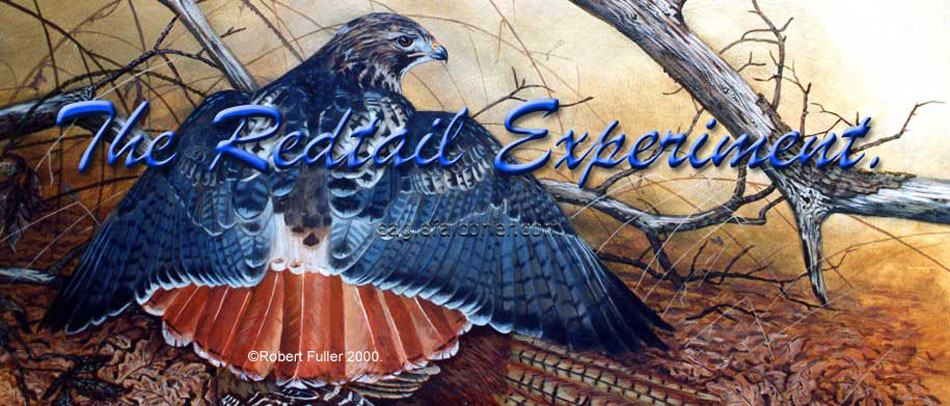'The Redtail Experiment.'
by
Alan Gates.
First Published in the Austringer 2001 No.33 
The idea formed out of a combination of requirements, but mainly it was the needs, perceived or otherwise, of my female golden eagle Maria, and the possibility that she might benefit from a repeated introduction of a foster eyas to rear. She had already reared a single redtail, followed by a pair of common buzzard eyases, but that was back in 1992, and this was 96 and I felt it was time to re-stimulate her parental instincts.
My source of common buzzard eyases, at the Royal Zoological Society of Scotland’s Edinburgh Zoo, had ceased due to the female of the breeding pair dying of old age, so I would have to look for another breeder.
A redtail eyas looked the most the most feasible and a local falconer and breeder, Ken Shaw was able to oblige. The purchase price of £400.00, for what was to be little more than a re-educational tool for my eagle, coupled with the fact that I would have the task of attempting to place it with another falconer, was starting to take the shine off this particular idea.
As I wrestled with my thoughts and tried to apply some justification for the project, the idea of a dual rearing project began to germinate, which would hopefully be of benefit to the eagle, as well as providing me with some practical education.
The possibility of success from my attempts to breed my golden eagles with the aid of voluntary artificial insemination was ever nearer. In the last two years I had managed to obtain fertile eggs, but the difficulty was in hatching these eggs. If that could be overcome I would then be faced with the decision of the eaglets rearing method. The idea of part parent reared and part socially imprinted was appealing. As opposed to full parent reared, with the subsequent conventional manning of a full grown eaglet.
By a combination of parent rearing and social imprinting, I would get the best of both worlds, if done correctly! This was the crux, I only had the theory in my head and no actual hard earned hands-on experience. Using a redtail as a miniature experiment would test that theory, it would enable me to purchase and or manufacture the necessary equipment I would require for future breeding of my eagle.
A redtail if mal-imprinted is one mean SOB and very territorial protective, just like an eagle. This temperamental tendency made the choice of a redtail for this experiment and ideal candidate. So having justified the project to myself, the experiment was underway.
On the evening of the 11th. May 1996 I visited my friend, falconer and breeder, Ken Shaw, who had three eyas redtails in his chamber, waiting for me, as previously arranged on the phone. We decided that the trio were made up of two males and a female. I favoured the female as she would have greater possibilities when she was mature, as both a brooder and a foster parent. Ken estimated she was nine days old and I confirmed that I would take her as soon as Maria was primed to accept to take an eyas.
The following day I had news that another redtail eyas would be available for me in Bristol, this was from a pair, of which the male, was the first eyas Maria foster reared. I made arrangements to collect it the following weekend. Things were starting to look good, Maria would now have a eyas to occupy her when I removed the female for social imprinting.
Monday morning, and the hen eggs started to hatch, these had been set so the hatching would synchronise with 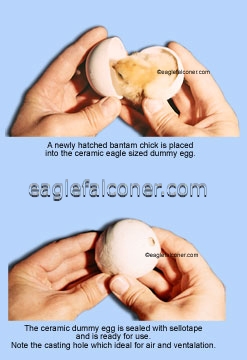 the estimated ninth day age of Ken’s eyases. the estimated ninth day age of Ken’s eyases.
The first hen chick was placed in the hollow ceramic egg and placed under Maria as she incubated her dummy eggs. At midday I returned to place a second hen chick, in another hollow egg, under Maria and to release the first chick.
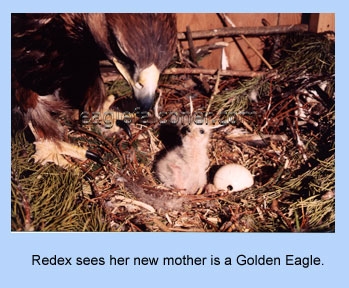 That evening (14th. May) I collected the female eyas redatil from Ken’s and placed it under Maria. She accepted it well, thus ending 51 days of incubation. The eyas had a good crop on it when introduced, so I left a rabbit leg on the nest for the following day. That evening (14th. May) I collected the female eyas redatil from Ken’s and placed it under Maria. She accepted it well, thus ending 51 days of incubation. The eyas had a good crop on it when introduced, so I left a rabbit leg on the nest for the following day.
In the morning I delivered a plucked quail to the nest - the eyas was well. At midday the quail was gone, but there was little evidence that the eyas had been fed. At 5.30 I left a rabbit leg on the nest, but by 7.00 p.m. the eyas had still not been fed so I intervened and fed it a crop. The following day Maria still seemed reluctant to feed the eyas, so at midday I fed it quail breast At 5.30 I left the front half of a leveret on the nest and when I returned at 7.30 p.m. she had fed the eyas the remainder of the quail.
All went well and the following day I collected and introduced the 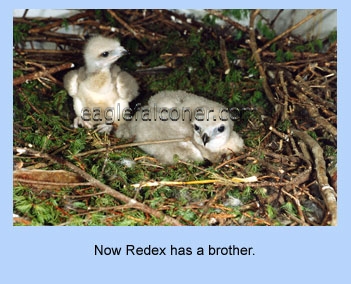 second eyas redtail. Maria accepted the second eyas without a hitch and both eyases were being fed the following morning when I entered the enclosure. second eyas redtail. Maria accepted the second eyas without a hitch and both eyases were being fed the following morning when I entered the enclosure.
On the 21 st. I ringed the female eyas and only just got the ring slipped on. She now about nineteen days old and growing well. By the 27th. the female eyas was starting to tear her own food, well enough for me to remove her from Maria and start to socially imprint her.
This process followed the usual course of late social imprinting. I built a stick nest in a plastic bowl and took this with me to work. When ever I placed fresh food down or needed to clean out the nest bowl, I placed a soft hood on her, routine was everything and things went well.
Everything followed the normal course, she ate slept and grew in full view of everyone, including my dog. As the time past I conjured with the thought that she never seemed to have a really full crop, she seemed to graze rather than have a blow out. I put this down to the fact that food was always available, and she would pick at it as she needed. Her weight was increasing, but as I had no guidelines for comparison I was unable to tell if she was progressing at a normal rate. Visually though, she looked fine.
Once she was fully feathered and standing on a scale I became more perplexed and somewhat concerned. At a couple of ounces over two pounds this was not the weight of a female, that Ken and I were convinced we had identified at nine days old. Feeling her keel she was not bodied up as I would have expected, more like a flying 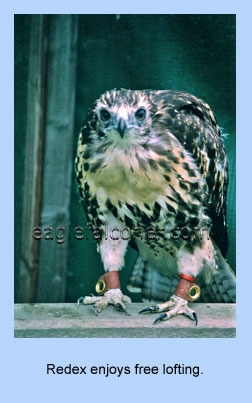 weight keel. weight keel.
She was getting a varied diet, with a choice of quail, rabbit, hare or pheasant, so there was no problem there, but no matter what was offered, she seemed to be satisfied with a third to half a crop. This started to play on my mind and I worried that if I left things as they were she would start to deteriorate. So I decided that whenever she stopped eating I would offer her tidbits. She took a few but not enough, so I started to push them down her throat. I knew full well I had reached one of those crisis points that needed strong decisions, and with the knowledge that in all probability, I could ruin all the previous work, I still felt I had no option.
Once she’d had about three quarters of a crop I let her rest for a while, when I returned she had regurgitated most of the extra food. I was exasperated, it was as if her crop was only comfortable at less than half full. Undeterred and with her welfare uttermost in my mind, I continued cutting up her food as though she was still a young helpless eyas. The diet consisted of quail breast, hare or rabbit heart and some liver, and it became a battle to keep a little more in the crop at each feed.
Very slowly her weight increased and I allowed her to resume feeding herself, things were improving and it was at this point that I started to feed her off a lure, in the paddock.
It was during these early days of getting her to fly down to the lure that she started to show signs of slight mantling. Nothing over hysterical, but the signs were there, and if I was not careful this vice would develop into full blown mantling.
I felt I had to change course yet again, if I continued without reacting to these subtle signs, I could end up bringing out the worst traits of an imprint.
Completely stumped for a solution I decided to hack her in our wood. It’s a mixed wood, mainly deciduous of around two acres, surrounded by farmland with a small river on the southern end. There is a healthy population 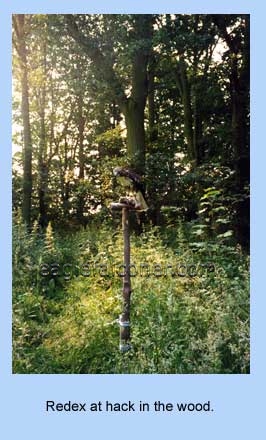 of rabbits and pheasants with some squirrels. I would feed her daily from a hack perch and wait until she’d killed, then think of a way to retrieve her. of rabbits and pheasants with some squirrels. I would feed her daily from a hack perch and wait until she’d killed, then think of a way to retrieve her.
The wood was about half a mile from my house across the fields, and I hoped it would contain her and keep her out of trouble. I was fortunate that it was sufficiently close for me to service her needs, twice a day.
All went well, she was often close by the feeding perch when I visited in the mornings, but she would wait until I was leaving before she approached to feed. I was just getting into the routine when on the fifth morning I found her on top of Maria’s weathering enclosure, outside the house. Clearly this woodland hack was not going to work now she knew her way home. I gathered her up and in desperation tossed her into Maria’s vacated breeding enclosure. There she stayed until mid September, isolated from the outside world, I dropped her food down the food chute and left her.
When I caught her up and jessed her, she finally confirmed her sexuality by tipping the scales at three and a half pounds. With her anorexic tendencies behind her, I set about trimming her weight in readiness to enter her at game.
Rabbits and pheasants were her forte, but I enjoyed her pheasant flights most 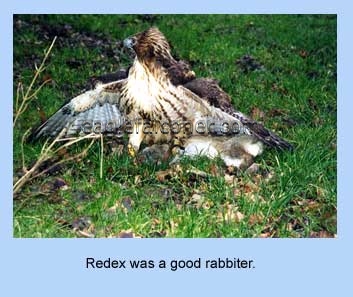 of all. The ones she brought to bag were mainly taken on the floor, when they had landed or were running into cover. She did at times, take them on in flight as they burst from cover and she ripped many a footfull of feathers out of rising pheasants, but always seemed to fluff her foothold. If she did not make contact in the first twenty to thirty yards of a flight she disengaged pursuit. of all. The ones she brought to bag were mainly taken on the floor, when they had landed or were running into cover. She did at times, take them on in flight as they burst from cover and she ripped many a footfull of feathers out of rising pheasants, but always seemed to fluff her foothold. If she did not make contact in the first twenty to thirty yards of a flight she disengaged pursuit.
After two enjoyable hunting seasons with her, she started her second moult at the beginning of the summer of ‘98 and I decided to construct a nest platform in her moulting enclosure. She was no nest builder, in fact she seemed to have more idea of demolition than construction. I finally left all the sticks on the floor and filled her platform with straw, which gave her six eggs a bed to lie on.
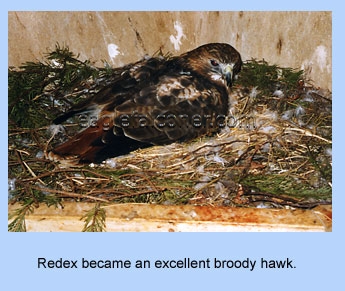 She became very tame as her hormonal level rose, for which I was grateful, as many Redtail’s become excessively aggressive in breeding condition. Her tameness, allowed me to handle her on eggs as I would a broody bantam, and although she has so far just incubated infertile eggs, I think she could develop into a good foster rearer. She became very tame as her hormonal level rose, for which I was grateful, as many Redtail’s become excessively aggressive in breeding condition. Her tameness, allowed me to handle her on eggs as I would a broody bantam, and although she has so far just incubated infertile eggs, I think she could develop into a good foster rearer.
As a personal education programme the dual rearing / social imprinting of this redtail did not pan out quite the way I had expected. A couple of spanners were thrown into the works which threw me off course, but in the end, I felt we both came through it with the original objectives achieved. Oh, and by the way I named her Redex, which is a shortened version of redtail experiment.
|
